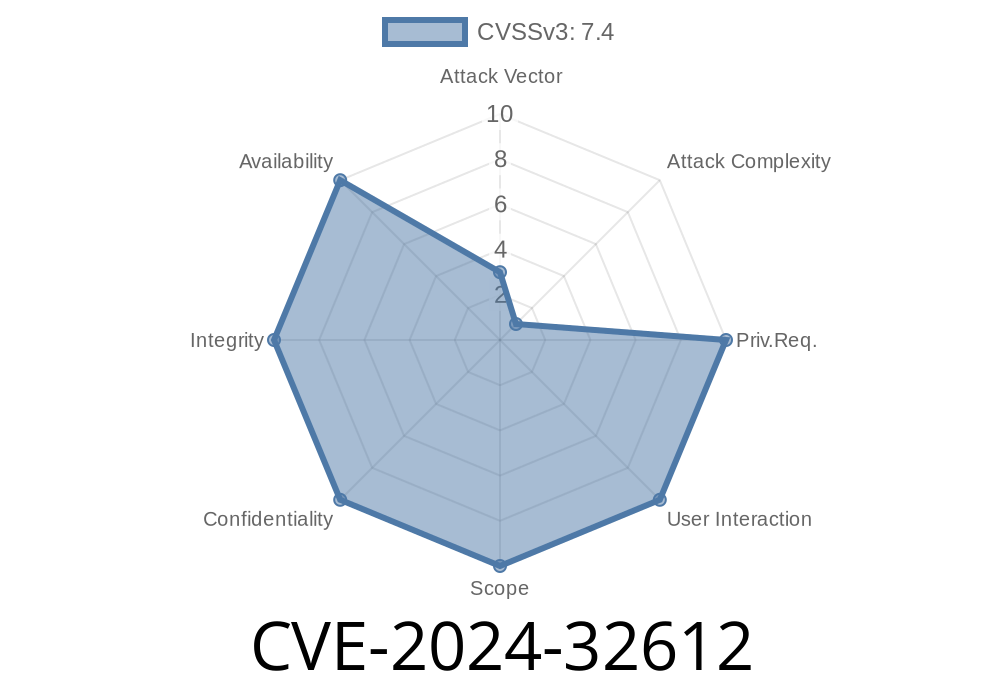If you're a software developer working with high-dimensional data and scientific file formats, chances are you're using the Hierarchical Data Format version 5 (HDF5) library for storing and managing your data. Unfortunately, a critical security vulnerability has been identified in this library, which you need to know about. CVE-2024-32612 refers to this heap-based buffer over-read vulnerability affecting all versions of the HDF5 library up to 1.14.3. This vulnerability is distinct from CVE-2024-32613, which affects the same codebase but presents a different attack vector.
In this post, we'll be discussing the technical details of the CVE-2024-32612 vulnerability, including code snippets and remediation measures. We'll also provide links to the original references for further reading.
Vulnerability Details
The heart of the issue lies in the H5HL__fl_deserialize function found in the H5HLcache.c source code file. Here's a simplified version of the vulnerable code snippet:
static herr_t
H5HL__fl_deserialize(const uint8_t *image, const size_t *heap_size)
{
H5F_t *f = NULL;
haddr_t hdr_addr = HADDR_UNDEF;
...
if (*heap_size < sizeof(H5HL_hdr_t))
HGOTO_ERROR(H5E_ARGS, H5E_BADVALUE, FAIL, "buffer too small")
...
UINT16DECODE(image, magic);
if (magic != H5F_HEAP_ID_LEN)
HGOTO_ERROR(H5E_HEAP, H5E_BADVALUE, FAIL, "bad heap signature")
...
UINT32DECODE_VAR(image, (size_t)local_heap->quantum_size);
heap_image = image;
...
memcpy(local_heap->buf, heap_image, (size_t)local_heap->quantum_size);
...
done:
return ret_value;
}
This function accepts a serialized image buffer as its input and attempts to deserialize it into a useful application format. However, there are two issues that arise from this code snippet.
1. The function fails to validate the length of the input buffer against the expected size. Although it checks whether the heap_size is less than the size of the header, it does not check whether the heap_size is of a valid length to prevent a heap-based buffer over-read.
2. When copying the serialized image buffer into the program's heap, the function uses memcpy without proper bounds checking, thus allowing an attacker to overflow the heap buffer. As a result, this can corrupt the program's instruction pointer, leading to potential remote code execution (RCE).
Exploitation
A malicious actor could exploit this vulnerability by crafting a specially designed image buffer that exceeds the expected limit. When the deserialization process runs, the attacker can cause a heap-based buffer over-read, potentially leading to an RCE.
CVE-2024-32612: https://cve.mitre.org/cgi-bin/cvename.cgi?name=CVE-2024-32612
HDF5 Library Homepage: https://www.hdfgroup.org/solutions/hdf5/
Mitigation and Remediation
As of now, the vulnerability exists in the HDF5 library up to version 1.14.3. To remediate this issue, you should make sure to:
1. Apply the latest security updates and patches provided by the HDF Group (the maintainers of the HDF5 library).
2. Review your codebase and ensure it thoroughly validates input buffers, preventing potential buffer overflows.
3. Implement proper bounds checking when using potentially dangerous functions such as memcpy, strncpy, and strcpy.
If you are currently using the HDF5 library in your projects, it is crucial to review your application's usage of the library and ensure you are properly protecting against potential heap-based buffer over-reads. By staying informed of security vulnerabilities such as CVE-2024-32612 and applying the appropriate measures, you can better protect your software from malicious attackers.
Timeline
Published on: 05/14/2024 15:36:46 UTC
Last modified on: 08/02/2024 02:13:40 UTC
